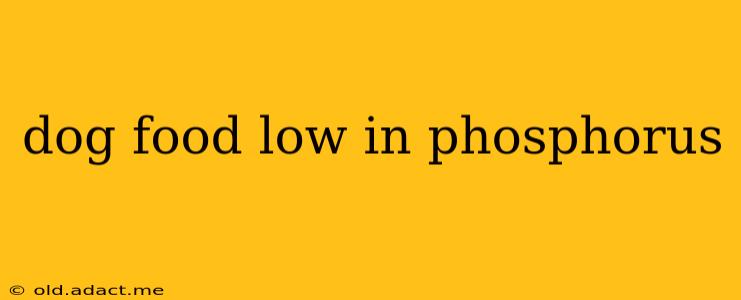Phosphorus is an essential mineral for dogs, playing a vital role in bone health, energy production, and overall bodily functions. However, for dogs with certain health conditions, like kidney disease, hyperparathyroidism, or certain types of bladder stones, a diet low in phosphorus is crucial. Choosing the right food can be challenging, so let's delve into the specifics of finding the best low-phosphorus dog food for your furry friend.
What is Phosphorus and Why is it Important for Dogs?
Phosphorus works in conjunction with calcium to build and maintain strong bones and teeth. It's also involved in numerous metabolic processes, including energy transfer and muscle function. A balanced level of phosphorus is vital for a healthy dog. However, an excess can be detrimental, particularly for dogs with compromised kidney function. Kidneys play a crucial role in filtering phosphorus from the blood, and when they are not functioning optimally, phosphorus can build up to dangerous levels.
What are the Signs of High Phosphorus in Dogs?
High phosphorus levels, or hyperphosphatemia, often don't show obvious symptoms in the early stages. However, as levels rise, you might observe:
- Lethargy and weakness: Your dog may seem less energetic than usual.
- Loss of appetite: They might show a decreased interest in food.
- Increased thirst and urination: This is often a symptom of kidney problems in general.
- Vomiting and diarrhea: Gastrointestinal upset can be a sign of various health issues, including mineral imbalances.
It's crucial to note: These symptoms are not unique to high phosphorus and could indicate other health problems. Regular veterinary checkups are essential for early diagnosis and management.
What Types of Dog Food are Low in Phosphorus?
Finding commercially available low-phosphorus dog food is easier than ever before. Look for these key indicators:
- Prescription Diets: Your veterinarian can prescribe specialized diets formulated for dogs with kidney disease or other conditions requiring phosphorus restriction. These diets are carefully balanced to meet your dog's nutritional needs while minimizing phosphorus content.
- Veterinary Diets: Similar to prescription diets, but often available through pet supply stores with veterinary recommendations.
- Commercially Available Low-Phosphorus Foods: Several brands now offer dog foods specifically marketed as "low phosphorus" or "renal support." Always check the guaranteed analysis on the packaging to verify the phosphorus content.
- Homemade Diets: With veterinary guidance, you can prepare homemade meals designed to meet your dog's needs while keeping phosphorus low. This requires careful planning and monitoring to ensure nutritional balance. Improperly balanced homemade diets can lead to deficiencies.
How Much Phosphorus is Too Much?
The amount of phosphorus considered "too much" varies greatly depending on your dog's size, breed, age, and underlying health conditions. The best way to determine the appropriate phosphorus intake for your dog is to consult your veterinarian. They can perform blood tests to assess your dog's phosphorus levels and recommend an appropriate dietary plan.
What Other Ingredients Should I Look for in Low-Phosphorus Dog Food?
Beyond phosphorus content, look for foods that are:
- High-quality protein: Essential for maintaining muscle mass and overall health.
- Adequate essential fatty acids: Support healthy skin and coat.
- Balanced electrolytes: Maintain proper fluid balance.
- Limited additives: Avoid unnecessary artificial colors, flavors, and preservatives.
Can I just reduce the amount of my dog's regular food?
No, simply reducing the amount of your dog’s regular food will not necessarily lower their phosphorus intake proportionally. The concentration of phosphorus remains the same, and reducing the quantity may lead to nutritional deficiencies. A specifically formulated low-phosphorus diet is crucial to ensure your dog receives all the necessary nutrients while managing phosphorus levels.
How Often Should I Have My Dog's Phosphorus Levels Checked?
The frequency of phosphorus level checks depends entirely on your dog's health condition and your veterinarian's recommendations. If your dog has a diagnosed condition requiring phosphorus restriction, regular monitoring is essential to ensure the diet is effective and to make necessary adjustments.
Choosing the right low-phosphorus dog food is vital for maintaining the health and well-being of your canine companion. Always consult your veterinarian to determine the best dietary plan for your individual dog's needs and to ensure early detection and management of any potential health issues. Remember, this information is for general knowledge and should not replace professional veterinary advice.
